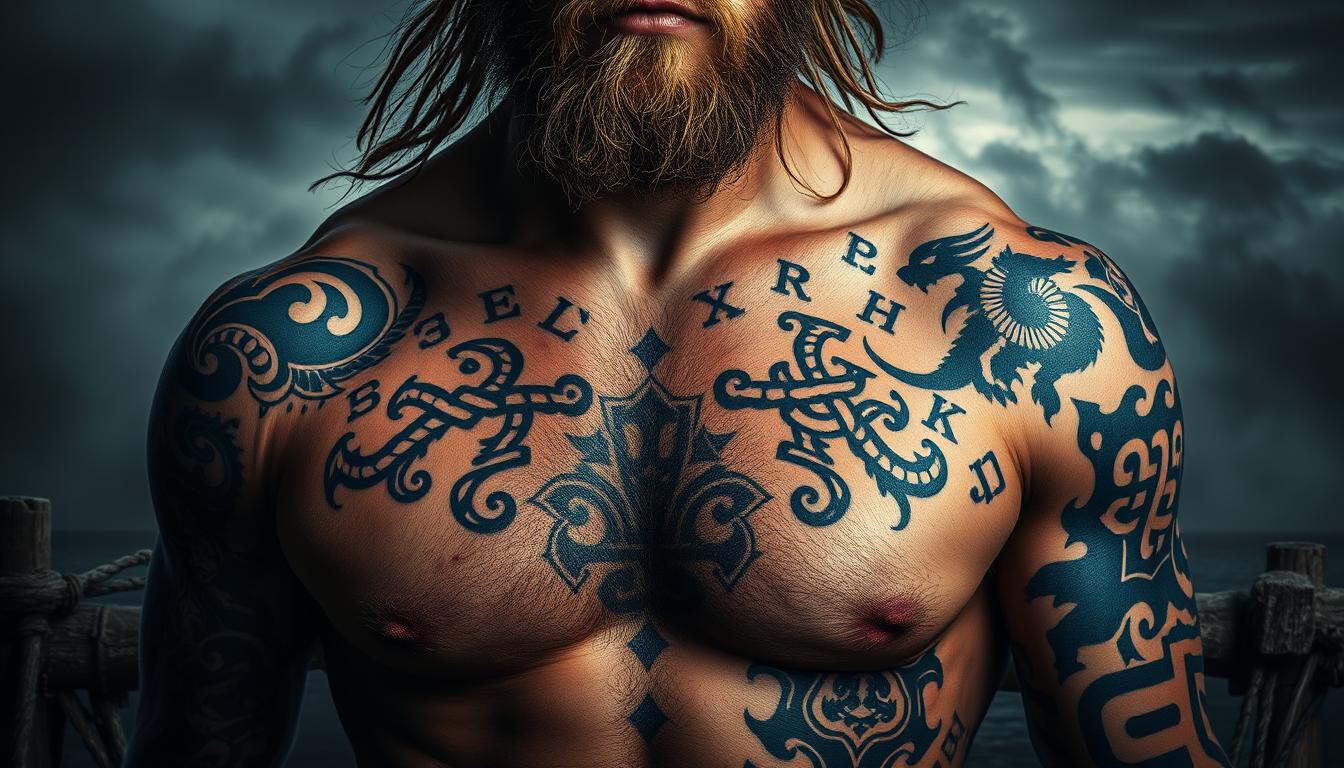
Step into the world of Viking tattoos, where ancient symbols and designs are full of deep meaning. These tattoos tell stories of bravery, honor, and spirituality, connecting us to our ancestors.
The rich history and culture behind these tattoos have experienced a significant resurgence in popularity as people seek meaningful body art. Each symbol carries its own unique meanings, from protection symbols like Thor’s hammer to spiritual connections like the Tree of Life.
Key Takeaways
- Viking tattoo symbols represent a powerful connection to ancient Norse culture.
- These tattoos tell stories of bravery, honor, and spiritual beliefs.
- Viking tattoos have become popular for their beauty and historical significance.
- Each symbol carries its own unique meaning and power.
- Understanding the meanings behind these symbols can enhance your tattoo journey.
The History and Significance of Viking Tattoos
The history of Viking tattoos is a rich tapestry of art, mythology, and symbolism. Viking historical tattoos have always caught our attention, and their significance extends far beyond mere decoration.
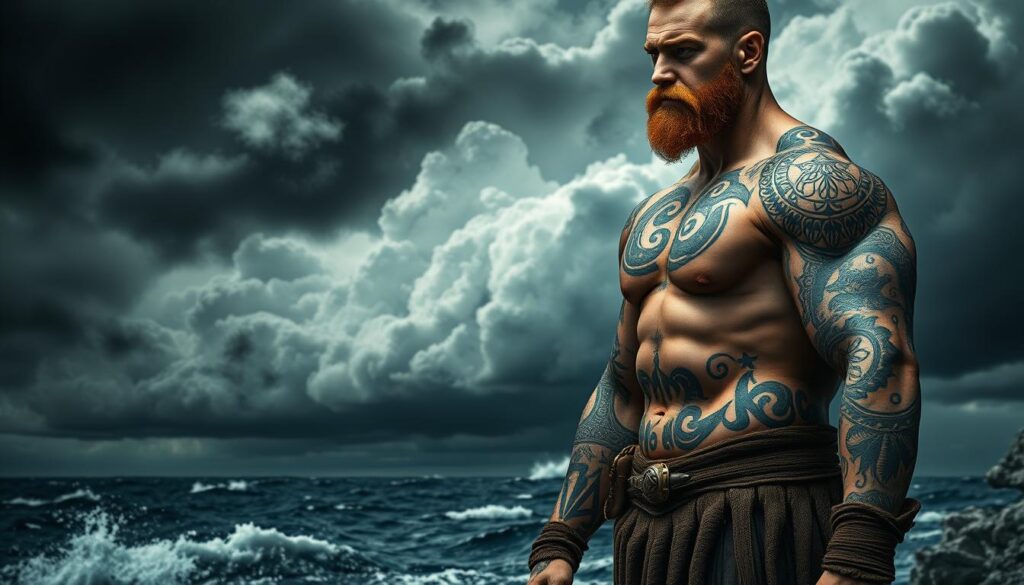
Origins of Viking Tattoo Art
The origins of Viking tattoo art date back to the early medieval period. Archaeological evidence from Viking graves has revealed preserved skin with tattoo markings, indicating that tattoos were an integral part of Viking culture. Historical accounts, such as those from Arabic scholar Ahmad Ibn Fadlan, describe Vikings with visible ink markings that contributed to their impressive appearance.
Cultural Importance in Viking Society
Viking tattoos served multiple purposes in their society; they weren’t just decorative but indicated social status, achievements, and spiritual beliefs within the community. The tattooing process was arduous and painful, using natural dyes and tools like sharpened bone or metal to create permanent markings that demonstrated the wearer’s courage. Warriors particularly embraced tattoos as symbols of bravery and accomplishment.
| Aspect | Significance |
|---|---|
| Social Status | Indicated rank or role in society |
| Achievements | Showcased bravery and battle prowess |
| Spiritual Beliefs | Connected the wearer to their gods and ancestors |
As noted by historian Olaf, “Tattoos were a visual language that communicated one’s identity, beliefs, and place within the Viking community.” The cultural importance of tattoos in Viking society extended beyond aesthetics, reflecting the broader artistic traditions of Norse culture.
Viking Tattoo Symbols and Their Meanings
Viking tattoo symbols are more than just aesthetically pleasing; they carry significant meanings rooted in Norse mythology. Each design holds a special meaning, reflecting the myths and legends of the Norse culture.
The Valknut: Odin’s Knot
The Valknut, also known as the “knot of the slain,” is a complex symbol consisting of three interlocked triangles. It represents Odin’s power over life and death, symbolizing the connection between the mortal world and the realm of the gods.
Mjölnir: Thor’s Hammer
Mjölnir, Thor’s mighty hammer, is a key symbol in Viking tattoos, representing strength, protection, and the power to overcome life’s challenges. It is a symbol of resilience that many people choose to tap into through their tattoos.
Yggdrasil: The Tree of Life
Yggdrasil, the cosmic Tree of Life, illustrates the interconnectedness of all nine worlds in Norse cosmology. It symbolizes the past, present, and future existing simultaneously, representing the continuity of life.
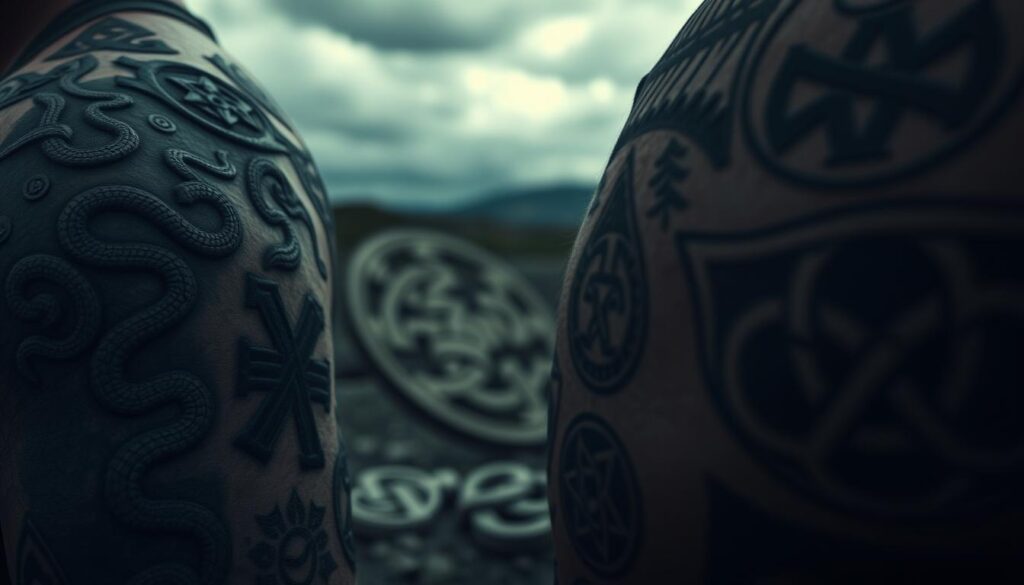
| Symbol | Meaning |
|---|---|
| Valknut | Odin’s power, life, death, and the afterlife |
| Mjölnir | Strength, protection, and resilience |
| Yggdrasil | Interconnectedness, past, present, and future |
Viking Rune Tattoos and Their Interpretations
For those drawn to Viking culture, rune tattoos provide a powerful means of expressing personal values and connections to the past. The ancient Viking alphabet, known as runes, was believed to be magical, and incorporating these symbols into body art can create designs that are both visually striking and deeply meaningful.
The Elder Futhark Alphabet
The Elder Futhark, the oldest form of the runic alphabet used by Germanic tribes including the Vikings, consists of 24 characters, each with its own sound, name, and mystical meaning. These characters can be combined to form words or poems, offering a wide range of creative options for tattoo designs. As stated by historians, “The runes were not just a means of communication but also a connection to the divine and the mysteries of the universe.“
Popular Runic Combinations and Their Meanings
Popular runes include Fehu, symbolizing wealth and abundance; Uruz, representing strength and untamed potential; Thurisaz, associated with protection; Ansuz, linked to wisdom and divine inspiration; and Raidho, signifying journey and life’s rhythm. When choosing runic tattoos, it’s crucial to work with an artist knowledgeable about the runic alphabet to ensure accurate translation and authentic representation. As seen in 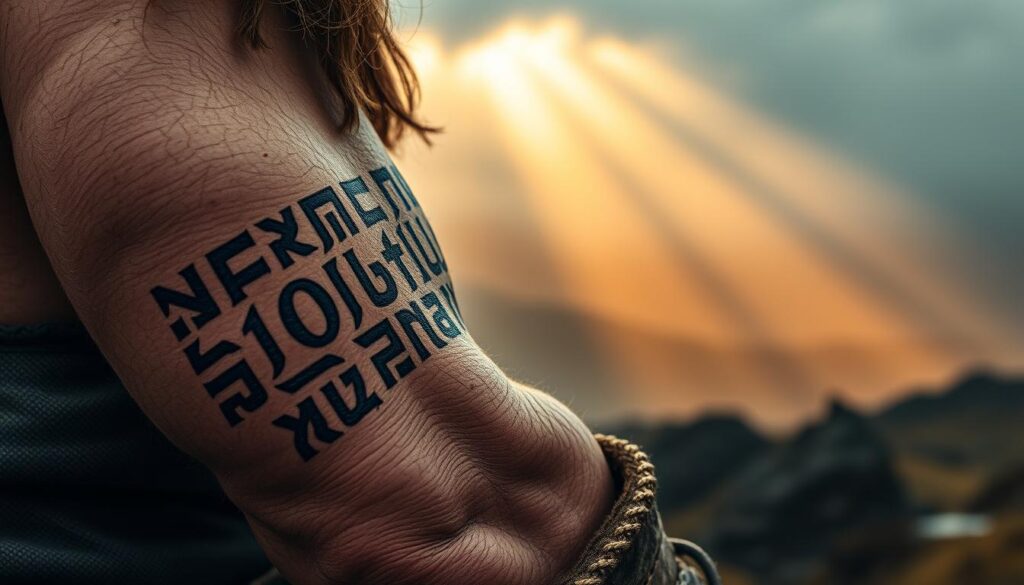 , the straight lines and angular nature of runes make them particularly well-suited for tattoo art.
, the straight lines and angular nature of runes make them particularly well-suited for tattoo art.
Animal Symbols in Viking Tattoos
In the realm of Viking tattoos, animal symbols play a pivotal role in representing various aspects of Norse mythology and the wearer’s personal attributes. These symbols are not merely decorative; they carry deep meanings tied to the mythology and cultural practices of the Viking age.
Huginn and Muninn: The Ravens of Odin
Ravens, particularly Huginn and Muninn, are closely associated with Odin, the All-Father. These ravens symbolize thought and memory, serving as messengers that fly across the world to gather information. A raven tattoo is often seen as a symbol of wisdom, knowledge, and insight beyond the physical realm.
Wolves and Fenrir
Wolves in Viking tattoos represent loyalty, strength, and the warrior spirit. The giant wolf Fenrir, destined to fight Odin during Ragnarök, embodies both fearsome power and the inevitable forces of chaos. A wolf tattoo signifies the wearer’s bravery and readiness to defend their beliefs.
Dragons and Serpents
Dragons and serpents, including the world serpent Jormungandr, symbolize primal power, protection, and the forces of nature. These creatures were revered and feared in Norse culture, making them potent symbols for those seeking to embody strength and resilience.
| Animal Symbol | Meaning |
|---|---|
| Ravens | Wisdom, Knowledge, Insight |
| Wolves | Loyalty, Strength, Warrior Spirit |
| Dragons/Serpents | Primal Power, Protection, Forces of Nature |
![]()
Warrior Viking Symbols Tattoos
Warrior Viking symbols tattoos have become increasingly popular among those drawn to Norse culture and its rich symbolism. These tattoos often feature powerful emblems that represent strength, protection, and spiritual significance. Two of the most revered symbols in Viking tattoo art are the Helm of Awe and the Vegvisir.
The Helm of Awe (Aegishjalmur)
The Helm of Awe, also known as Aegishjalmur, is a symbol of protection and bravery. Historically, it was believed to grant the wearer invincibility in battle and the courage to face life’s challenges. This eight-armed symbol was often painted or carved between a warrior’s eyes before battle, creating an intimidating appearance while providing magical protection. Modern tattoo interpretations of the Helm of Awe often incorporate additional Viking elements or personalized details while maintaining the powerful eight-spoke design.
The Vegvisir (Viking Compass)
The Vegvisir, often referred to as the Viking Compass, is another protective symbol that was believed to help the bearer find their way through rough weather and unfamiliar territory. This magical stave consists of eight different arms with unique endings, symbolizing the different challenges one might face on life’s journey. While sometimes confused with the Helm of Awe due to their similar eight-armed structure, the Vegvisir specifically represents guidance rather than protection in battle. For those interested in exploring more tattoo designs, you can visit https://nailcutandink.com/beautiful-tattoos/ for inspiration.
| Symbol | Meaning | Significance in Viking Culture |
|---|---|---|
| Helm of Awe | Protection and Bravery | Granted invincibility in battle |
| Vegvisir | Guidance and Navigation | Helped navigate through challenges |
Both the Helm of Awe and the Vegvisir make meaningful tattoos for those seeking reminders of inner strength, protection, and the ability to navigate life’s challenges with courage and wisdom. These warrior symbols connect the wearer to the Viking tradition of facing adversity with bravery and determination, making them popular choices for those drawn to Norse warrior culture.
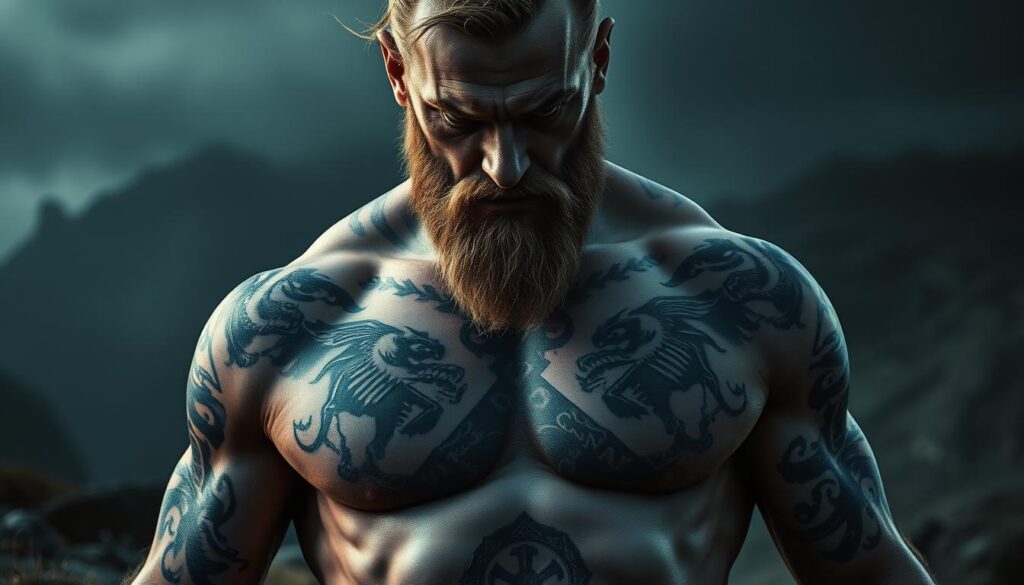
Norse Mythology Inspired Tattoo Designs
The world of Norse mythology is filled with fascinating figures and epic tales that can be translated into unique and captivating tattoo designs. This rich tapestry of stories and characters offers depth and meaning beyond mere decoration, making Norse mythology a popular choice for tattoo inspiration.
Gods and Goddesses
Norse mythology is replete with gods and goddesses, each embodying distinct qualities and domains. Odin, the All-Father, represents wisdom, poetry, war, and death, often depicted with his ravens Huginn and Muninn. Thor, the god of thunder, symbolizes strength, protection, and fertility, making his image or his hammer Mjölnir a popular choice for tattoos.
Epic Tales and Battles
Epic tales from Norse mythology, such as the creation myth of Yggdrasil and the prophesied end-times of Ragnarök, provide dramatic narrative scenes that translate beautifully into larger tattoo pieces. The battle of Ragnarök, where gods and giants clash, makes for particularly dynamic tattoo compositions.
| Mythological Figure | Symbolism | Tattoo Design Inspiration |
|---|---|---|
| Odin | Wisdom, Poetry, War, Death | Ravens, Valknut symbol |
| Thor | Strength, Protection, Fertility | Mjölnir (Thor’s Hammer) |
| Loki | Trickery, Transformation | Horned helmet, Serpent |
![]()
Celtic Influence on Viking Tattoo Art
Viking tattoo art is not just about Norse symbols; it also incorporates significant Celtic influences. The cultural exchange between Vikings and Celts led to a unique fusion in tattoo art, blending the rich heritage of both cultures.
Shared Symbols and Patterns
The artistic traditions of the Vikings and Celts shared many similarities and influenced each other through centuries of cultural exchange, trade, raids, and settlements. Celtic knots, with their intricate interlacing patterns symbolizing the interconnectedness of life and the eternal nature of the soul, complement Viking artistic sensibilities perfectly. The Tree of Life concept appears in both Celtic and Norse traditions, making it a natural bridge between the two artistic styles in tattoo designs.
| Symbol | Celtic Significance | Norse Significance |
|---|---|---|
| Tree of Life | Represents the connection between heaven and earth | Yggdrasil, symbolizing the interconnectedness of all things |
| Ravens | Associated with wisdom and prophecy | Huginn and Muninn, Odin’s messengers |
| Knots | Symbolize eternal life and spiritual growth | Used in various designs to represent life’s connections |
Blending Celtic and Norse Elements
Modern tattoo artists often create unique designs that blend the geometric precision of Viking art with the flowing, organic quality of Celtic patterns. When Celtic knot patterns are used to form the branches and roots of Yggdrasil, the result is a visually stunning tattoo that honors both cultural traditions. This cultural fusion in tattoo art highlights the historical connections between these ancient peoples while creating distinctive designs that are both meaningful and aesthetically pleasing.
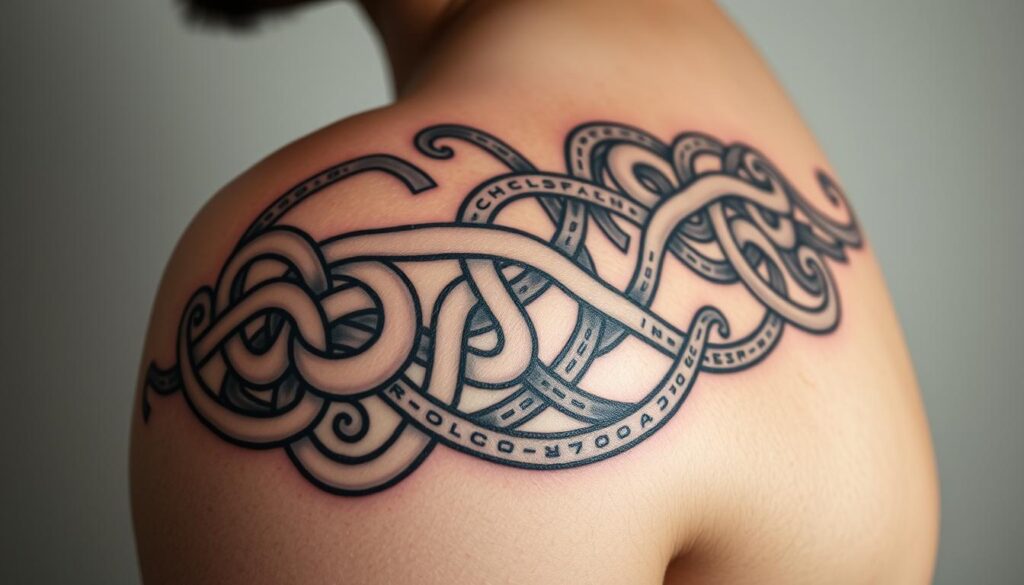
By incorporating elements from both traditions, tattoo enthusiasts can create pieces that honor multiple aspects of their heritage or spiritual interests. The blending of Celtic and Norse elements in Viking tattoos not only reflects the historical cultural exchange but also enriches the art form, making it more diverse and captivating.
Choosing the Right Viking Tattoo Design
To choose a Viking tattoo that truly resonates with you, it’s crucial to explore the meanings behind various Viking symbols. Viking tattoos are deeply rooted in Norse mythology, history, and culture, making it essential to understand the significance of the designs you’re drawn to.
Personal Meaning and Connection
When selecting a Viking tattoo design, consider what aspects of Norse culture and mythology resonate with you personally. Think about the values and qualities you wish to embody, such as strength, courage, protection, and spirituality, which are commonly symbolized in traditional Viking tattoos.
Reflecting on your personal journey and the themes that are most meaningful to you will help you choose a design that is not only aesthetically pleasing but also deeply significant.
Research and Authenticity
Thorough research is vital when choosing a Viking tattoo design. Many Viking symbols have nuanced or multiple meanings that have evolved over time. Consult reputable sources and work with a knowledgeable tattoo artist to ensure the authenticity and proper execution of your chosen design.

By combining your personal connection to the design with thorough research, you can create a unique and meaningful Viking tattoo that honors the cultural heritage from which it originates.
Placement Options for Viking Tattoos
The location of your Viking tattoo can significantly impact its overall aesthetic and personal significance. Different body locations offer unique advantages for showcasing these powerful symbols.
Traditional Placements
Arms remain one of the most popular placement options for Viking tattoos, with the forearm and bicep providing excellent visibility and ample space for detailed designs. The chest, particularly over the heart, offers a more intimate placement that can emphasize the deep personal significance of symbols representing courage, loyalty, or spiritual protection.
Modern Considerations
When considering placement, think about the size and complexity of your chosen design. Modern considerations for tattoo placement include visibility in professional settings, how the design might age with your body over time, and pain tolerance for different body areas. It’s also essential to consult with your tattoo artist about how different placements might affect the design’s appearance and longevity.
Viking Sleeve Tattoos: Telling a Story Through Ink
Viking sleeve tattoos offer a unique way to showcase your love for Nordic culture and mythology. These comprehensive tattoos cover the entire arm, from shoulder to wrist, allowing you to mix various Viking symbols and elements into one cohesive design.
Combining Multiple Symbols
One of the key benefits of Viking sleeve tattoos is the ability to combine multiple symbols that hold personal significance. You can incorporate iconic symbols like the Valknut, Mjölnir, and Yggdrasil into your design, creating a personalized narrative that reflects your journey and values.
Creating a Cohesive Narrative
To create a cohesive narrative, it’s essential to work closely with a skilled tattoo artist who understands how to balance different elements while maintaining visual harmony. Consider how different symbols relate to each other and how they can flow together around the contours of your arm. Popular narrative themes include Odin’s ravens flying over battlefields or the great tree Yggdrasil connecting the nine worlds.
A well-designed Viking sleeve tattoo becomes more than just body art; it’s a powerful expression of identity that tells your personal story through the lens of Norse mythology and symbolism.
Modern Interpretations of Viking Tattoo Art
Contemporary tattoo artists are revolutionizing Viking tattoo art by combining traditional Norse imagery with modern artistic approaches. This blend of old and new is giving rise to fresh and exciting tattoo designs that appeal to a wide range of enthusiasts.
Contemporary Artists and Styles
Artists like Jenna Kerr and Tom Bartley are at the forefront of this movement. They are reimagining traditional Viking symbols through various styles, including realism, watercolor, and geometric patterns. Kerr’s work, for instance, combines vibrant colors with intricate patterns, honoring the historical significance of Viking tattoos while exploring new techniques.
Evolving Meanings and Symbolism
The meanings associated with Viking tattoos are also evolving. While they still honor the core values of Viking culture—bravery, strength, and spirituality—they now also reflect individual stories and aesthetic preferences. This evolution is reflected in the diverse range of designs available, from traditional symbols like the Vegvisir and Helm of Awe to more modern interpretations that incorporate elements from other artistic traditions.
| Traditional Symbol | Modern Interpretation | Meaning |
|---|---|---|
| Vegvisir | Guiding Compass | Navigation and Protection |
| Helm of Awe | Protective Emblem | Strength and Courage |
| Mjolnir | Thor’s Hammer | Power and Protection |
Finding the Right Tattoo Artist for Your Viking Tattoo
To ensure your Viking tattoo is authentic and meaningful, you need an artist with the right expertise. The key to a great Viking tattoo lies in finding an artist who specializes in Norse imagery and symbolism.
Expertise in Norse Imagery
Look for artists who have a proven track record in creating Viking tattoos. Their portfolio should showcase detailed and accurate designs that reflect a deep understanding of Norse symbols and their meanings. A good artist will be familiar with the cultural significance behind different symbols, such as the Valknut and Mjölnir, and be able to guide you toward choices that accurately reflect Viking heritage.
| Artist Criteria | What to Look For |
|---|---|
| Portfolio | Detailed and accurate Viking designs |
| Knowledge of Norse Symbols | Understanding of cultural significance and meanings |
| Client Reviews | Positive feedback on their work and professionalism |
Consultation and Portfolio Review
Schedule consultations with potential artists to discuss your ideas and gauge their knowledge and enthusiasm. During the consultation, ask about their approach to creating authentic Viking designs and their aftercare recommendations. A reputable artist will be transparent about their process, timeline, and pricing, helping you feel confident and prepared throughout your tattoo journey.
By doing your research and finding an artist who is well-versed in Viking tattoo art, you can ensure that your tattoo is not only visually stunning but also rich in meaning and authenticity.
Caring for Your New Viking Tattoo
A well-cared-for Viking tattoo is not only a beautiful work of art but also a lasting symbol of Norse culture. To ensure that your tattoo heals properly and maintains its vibrant appearance, follow a careful aftercare routine.
Immediate Aftercare
Immediately after getting your Viking tattoo, follow your artist’s specific instructions. Typically, this includes keeping the area clean with mild, fragrance-free soap and lukewarm water. Gently pat the area dry with a clean, soft towel and apply a thin layer of recommended moisturizer or aftercare product.
- Keep the tattoo clean and moisturized to prevent scabbing.
- Avoid direct sunlight and soaking in water.
- Wear loose, breathable clothing to avoid irritation.
Long-term Maintenance
To keep your Viking tattoo looking great, protect it from the sun with high-SPF sunscreen. Regular moisturizing helps maintain skin elasticity and vibrancy, preventing the tattoo from becoming dull or faded over time.
| Care Tips | Benefits |
|---|---|
| Use high-SPF sunscreen | Protects from UV damage |
| Moisturize regularly | Maintains skin elasticity and vibrancy |
| Avoid picking or scratching | Prevents infection and damage |
By following these care guidelines, your Viking tattoo will remain a powerful and beautiful symbol of your connection to Norse culture for many years.
Viking Tattoos for Women
The notion that Viking tattoos were exclusive to men is being challenged by historical evidence suggesting women also wore body art. Viking women lived similar lives to men, and it’s likely they had similar tattoos. Historical sources confirm that Viking women wore tattoos, making depictions of tattooed female warriors in media potentially accurate.
Historical Significance
Viking tattoos for women have a rich historical foundation. Evidence suggests that Viking women wore tattoos reflecting their status, beliefs, and accomplishments in Norse society. Shield-maidens and women in positions of authority likely wore tattoos symbolizing their roles.
Modern Designs
Modern interpretations of Viking tattoos for women incorporate traditional symbols with feminine elements. Popular designs include Freyja-inspired imagery, delicate rune work, and symbols like Mjölnir or the Vegvisir. Women often honor powerful female figures from Norse mythology, such as Valkyries or goddesses, in their tattoo designs.
Contemporary feminine Viking tattoo styles feature softer lines, floral elements, and delicate placements while maintaining Norse symbolism. The growing popularity of Viking-inspired media has increased interest in Norse tattoos among women who connect with the strength and independence of Viking culture.
Viking Tattoo Styles and Techniques
Viking tattoos represent a blend of Norse mythology, historical art, and personal style, offering a wide range of design possibilities. The art of Viking tattoos is deeply rooted in the cultural heritage of the Viking Age, with various styles and techniques emerging over time.
Traditional vs. Contemporary Approaches
Viking tattoo styles range from traditional approaches based on historical art forms to contemporary interpretations that blend Norse elements with modern tattoo techniques. Traditional Viking tattoo styles draw directly from historical art periods like the Oseberg, Jelling, and Mammen styles. The Oseberg style is characterized by intricate wood carvings, while the Jelling style features interlacing creatures in S-shaped forms. The Mammen style, on the other hand, is known for its elongated waves and loose tendrils.
- Traditional Styles: Authentic frameworks for tattoo designs that capture the artistic sensibilities of the Viking Age.
- Contemporary Approaches: Incorporate techniques like realism, watercolor, blackwork, or geometric styles while maintaining Norse symbolic elements.
Color Choices and Their Significance
Color choices in Viking tattoos can carry significant meaning. Traditional designs often use black ink exclusively, reflecting the historical limitations of Viking art materials. Modern interpretations, however, might use blues and greens to represent the sea, reds for blood and battle, or earth tones to connect with the natural world.
- Symbolic Colors: Blues and greens for the sea, reds for blood and battle, earth tones for nature.
- Aesthetic Variations: Some artists specialize in creating aged or weathered looks, mimicking ancient carvings or runestones.
When choosing a style for your Viking tattoo, consider both aesthetic preferences and how different techniques might affect the longevity and impact of your design.
Conclusion
Embracing Viking tattoos means embracing a legacy of strength, wisdom, and community. These symbols of Norse culture continue to inspire people worldwide, connecting them to their roots and the strength of Norse warriors. When choosing a Viking tattoo, pick designs that match your values and beliefs.
Whether it’s a small symbol or a full sleeve, your tattoo will remind you of the wisdom and courage of the Viking warriors. By mixing Norse mythology, Celtic influence, and modern styles, you can create a tattoo that’s uniquely yours. Viking tattoos are more than just body art; they honor the spirit of a remarkable people.
